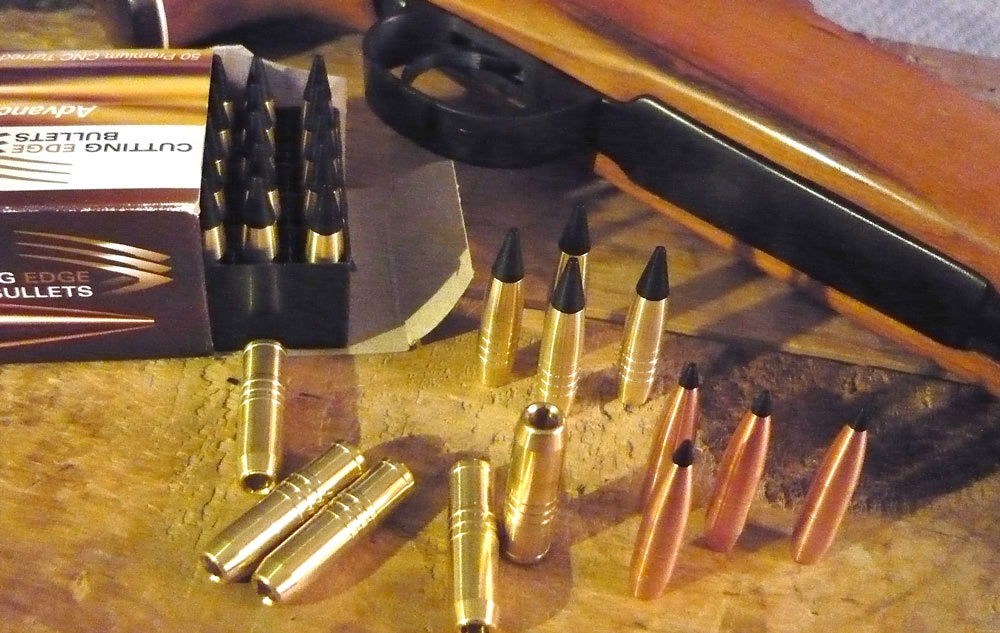At GunDigest, we independently review products. However, we may earn a commission when you purchase through links on our site. Learn More
The Unique Challenges, Performance of Monometal Bullets

Monometal bullets can offer shooters top-notch performance, especially for hunting. But the futuristic projectiles challenge reloaders, given their unique characteristics.
In the late 1980’s, Mr. Randy Brooks, owner of Barnes Bullets, sat on a patch of high ground in Alaska glassing for bears and had a brilliant idea.
His vision was to create a bullet that would expand reliably, yet penetrate deeply and not come apart. It was the concept of removing the entire lead core, leaving a bullet made of a solid copper (usually just reserved for the jacket material) that was completely revolutionary.
Now I have to be completely honest here, and it’s something Mr. Brooks and I have discussed before. Years ago, when I read about the Barnes X bullet for the first time, I fell head over heels for the concept of this bullet in the hunting fields. I went out and bought several boxes, in .308” diameter and .375”, but, they gave me fits.
No matter what I tried, I simply could not get the accuracy I wanted from them. I changed seating depths, I changed powder and I changed primers, all with no avail. I cursed this bullet, and shelved the idea of using them. That is, until several customers called Massaro Ballistic Laboratories and asked me to load them some of the improved TSX bullets.
Reluctantly (at first) I did what the customer wanted, and when the reports came back I cocked an eyebrow. Accuracy was superb, velocities were spot on, and the field performance was stellar. You see, the bullet design was revised to include three deep groves in the shank in order to lower the amount of bearing surface, and keep pressures down. This did the trick. The Barnes TSX and TTSX models are a damned fine bullet, and I wouldn’t argue with anyone choosing this bullet for hunting.
The monometal bullet design is here to stay, and there’s no doubt about that. But there are several features and little quirks that any handloader should know about them.
Copper is lighter than lead. Therefore, to maintain the same weight, the copper bullet must be longer. This can pose an issue in cartridges that have a smaller capacity, as the bullet will need to be seated deeper into the case. But, one of the great features of the copper bullets is that their construction is rigid enough that lighter-for-caliber bullets will perform as well as their heavier weight cup-and-core siblings.
A 150 grain .308” monometal will do the job as well as some of the 180 grain conventional varieties. It is, in my opinion, the lighter weight bullets that make the monometal bullets really shine.
If a shooter is recoil sensitive, these can be a cure for what ails. For example, if you load a 270 grain .375″ monometal bullet in the .375H&H case to the same speed as a conventional 300 grain (2,550 fps or thereabout), and you have a perfectly viable buffalo cartridge, with a significant drop in felt recoil. If you are a fan of the .338” bores, you can create a great deer load by using a 175 grain monometal, thereby getting more field time for a gun usually reserved for God’s larger mammals.
On the flip-side, if you are enamored with the .257″ bores, you can ethically hunt creatures that usually require a larger diameter bullet by switching to a premium monometal bullet.
These bullets can be a bit more difficult to load for, though. Maybe I should say they are a bit more finicky in what they need to be driven accurately.
I’ve found, for reasons that I can’t explain, that the all copper bullets tend to perform better with powders that are on the faster side of the burn rate among the list of suitable powders. I’ve also found that the ball powders, like Hodgdon’s H380 or H414 can tighten up group sizes when using the copper projectiles.
A variation of seating depth can dramatically affect your group size also. A change of as little as 0.010” can make or break the deal. Experiment with the seating depth, but be sure that you don’t seat your bullets out so far as to interfere with feeding from your rifle’s magazine.
Although Barnes pioneered the monometal bullet, they aren’t the only manufacturer of this style. Nosler, famous for its Partition and Ballistic Tip, offers what they call the “E-Tip” bullet, which has performed very well, and Hornady makes the GMX (Gilding Metal eXpanding) which has given some excellent results.
Cutting Edge Bullets is a company that I’m really excited about. Hailing from neighboring Pennsylvania, they produce a series of all copper, lathe turned projectiles that should prove to be a winner. The Raptor and Lazer line of bullets are long, lean hollow points, and some are available with a black polymer tip to raise the ballistic coefficient for long range work. The tolerances of these bullets are held very tight, and they will be joining me in the field this upcoming season.
All of the solid copper bullets are perfectly suitable for hunting in certain areas of a particular (silly) West-Coast state that has banned the use of lead-core ammunition.
If you’re looking for something different for your rifles, take a long look at some of the bullets I’ve mentioned, and give them a try. They can make your rifles that much more versatile!
Next Step: Get your FREE Printable Target Pack
Enhance your shooting precision with our 62 MOA Targets, perfect for rifles and handguns. Crafted in collaboration with Storm Tactical for accuracy and versatility.
Subscribe to the Gun Digest email newsletter and get your downloadable target pack sent straight to your inbox. Stay updated with the latest firearms info in the industry.